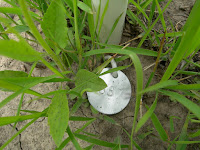
 Ok, Ok, it's only thirsty, but the Phactor is being dragged across the country for the weekend, and with the formerly trusty laptop inoperative, it will be a vacation from email, blogging, and all the rest. So the only thing to do is post the Friday Fabulous Flower today. Our Missouri evening primrose began flowering yesterday, and it's among my favorite native species. They love sunny, exposed sites and deal with dry conditions quite well. It also is the largest flower in our garden, at least in length, some 25-26 cm long because of the hypanthium (The winged ovary is way on the left). Although formerly Oenothera missouriensis, it is now Oenothera macrocarpa, but that won't compute in the memory banks. Similarly students are filed in my memory by their maiden names; get married if you want, but don't expect me to remember you that way.
Ok, Ok, it's only thirsty, but the Phactor is being dragged across the country for the weekend, and with the formerly trusty laptop inoperative, it will be a vacation from email, blogging, and all the rest. So the only thing to do is post the Friday Fabulous Flower today. Our Missouri evening primrose began flowering yesterday, and it's among my favorite native species. They love sunny, exposed sites and deal with dry conditions quite well. It also is the largest flower in our garden, at least in length, some 25-26 cm long because of the hypanthium (The winged ovary is way on the left). Although formerly Oenothera missouriensis, it is now Oenothera macrocarpa, but that won't compute in the memory banks. Similarly students are filed in my memory by their maiden names; get married if you want, but don't expect me to remember you that way. 


















 Give me your answer before you read on.
Give me your answer before you read on. 



